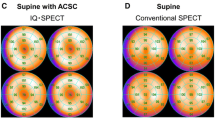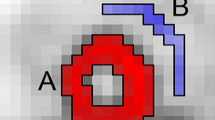Abstract
Regional variation of tracer distribution is seen in uncorrected thallium-201 images of normal hearts. This study evaluates the effect of attenuation correction on myocardial201Tl distribution in patients with low risk of coronary artery disease. An L-shaped dualdetector single-photon emission tomographic system equipped with a pair gadolinium-153 scanning line sources was used for sequential emission/transmission imaging in 36 patients (14 men and 22 women) with less than 5% risk for coronary artery disease. Uncorrected emission images were reconstructed using filtered back-projection (FBP) whereas the attenuation corrected (AC) images were iteratively reconstructed using the attenuation map computed from the transmission data. Both sets of images were reorientated into short axis, vertical long axis and horizontal long axis images. For quantification data were reconstructed into polar plots and count density estimated in 17 myocardial segments. The population % standard deviation for each segment of AC data was significantly smaller than that for FBP data, indicating improved homogeneity of tracer distribution. In men the anterior-basal inferior activity ratio improved from 1.20 for FBP to 0.96 for AC (stress) and from 1.23 for FBP to 0.98 for AC (delay) (P<0.0001). In women the anterior-basal inferior activity ratio changed from 1.08 for FBP to 0.94 for AC (stress) and from 1.08 for FBP to 0.93 for AC (delay) (P<0.001). These ratios reflect appropriate compensation for basal attenuation but a lack of scatter correction. The lateral—septal activity ratio in men changed from 1.05 for FBP to 0.99 for AC (stress) and from 1.02 for FBP to 0.96 for AC (delay), while in women it changed from 1.05 for FBP to 0.98 for AC (stress) and from 1.04 for FBP to 0.98 for AC (delay) (P<0.005 in all cases). The apex of AC images showed a decrease in activity consistent with wall thining at this site. It is concluded that the use of attenuation correction yields improved homogeneity of myocardial tracer distribution in patients with low risk of coronary artery disease. The diagnostic benefits of attenuation correction are yet to be fully assessed.
Similar content being viewed by others
References
Mahmarian JJ, Verani MS. Exercise thallium-201 perfusion scintigraphy in the assessment of coronary artery disease.Am J Cardiol 1991; 67: 2D–11D.
Eisner RL, Tams MJ, Cloninger K, et al. Normal SPECT thallium-201 bull's-eye display: gender differences.J Nucl Med 1988; 29: 1901–1909.
Cohen M, Touzery C, Cottin Y, et al. Quantitative myocardial thallium single-photon emission computed tomography in women: demonstration of age-related differences.Eur J Nucl Med 1996; 23: 25–30.
DePasquale EE, Nody AC, DePuey EG, et al. Quantitative rotational thallium-201 tomography for identifying and localising coronary artery disease.Circulation 1988; 77: 316–327.
Rabinovitch M, Suissa S, Elstein J, et al. Sex-specific criteria for interpretation of thallium-201 myocardial uptake and washout studies.J Nucl Med 1986; 27: 1837–1841.
Manglos SH, Thomas FD, Gagne GM, Hellwig BJ. Phantom study of breast tissue attenuation in myocardial imaging.J Nucl Med 1993; 34: 992–996.
DePuey EG, Garcia EV. Optimal specificiy of thallium-201 SPECT through recognition of imaging artifacts.J Nucl Med 1989; 30: 441–449.
Tsui BMW, Zhao XD, Gregoriou GK, et al. Quantitative cardiac SPECT reconstruction with reduced image degradation due to patient anatomy.IEEE Trans Nucl Sci 1994; 41: 2838–2848.
Pryor DB, Harrell FE, Lee KL, Califf RM, Rosati RA. Estimating the likelihood of significant coronary artery disease.Am J Med 1983; 75: 771–780.
Pryor DB, Shaw L, Harrell FE, et al. Estimating the likelihood of severe coronary artery disease.Am J Med 1991; 90: 553–562.
Shepp LA, Vardi V. Maximum likelihood reconstruction for emission tomography.J Comput Assist Tomogr 1982; M1-1: 113–122.
Tan P, Bailey DL, Meikle SR, Erbel S, Fulton RR, Hutton BF. A scanning line source for simultaneous emission and transmission measurements in SPECT.J Nucl Med 1993; 34: 1752–1760.
Diamond GA, Forrester JS. Analysis of probability as an aid in the clinical diagnosis of coronary artery disease.N Engl J Med 1979; 300: 1350–1358.
Maddahi J, Garcia EV, Berman DS, et al. Improved noninvasive assessment of coronary artery disease by quantitative analysis of regional stress myocardial distribution and washout of thallium-201.Circulation 1981; 64: 924–935.
Tsui BMW, Gullberg GT, Edgerton ER, et al. Correction of nonuniform attenuation in cardiac SPECT imaging.J Nucl Med 1989; 30: 497–507.
Ball RM, Bache RJ, Cobb ER, Greenfield JC. Regional myocardial blood flow during graded treadmill exercise in the dog.J Clin Invest 1975; 55: 43–49.
Schwaiger M, Muzik O. Assessment of myocardial perfusion by positron emission tomography.Am J Cardiol 1991; 67: 35D–43D.
Beanlands RS, Muzik O, Hutchins GD, Wolfe ER Jr, Schwaiger M. Heterogeneity of regional nitrogen-13-labeled ammonia tracer distribution in the normal heart: comparison with rubidium-82 and copper-62-labeled PTSM.J Nucl Cardiol 1994; 1: 225–235.
DePuey EG, Garcia EV. Prone versus supine thallium myocardial SPECT: a method to decrease artefactual interferior wall defects.J Nucl Med 1989; 30: 548–555.
Maniawski PJ, Miller SD, Morgan HT. Combined attenuation and scatter correction significantly reduces the effect of extracardiac activity on Tl-201 myocardial perfusion SPECT [abstract].J Nucl Med 1996; 37: 214.
King MA, Xia W, deVries DJ, et al. A Monte Carlo investigation of artifacts caused by liver uptake in single-photon emission computed tomography perfusion imaging with technetium 99m-labeled agents.J Nucl Cardiol 1996; 3: 18–29.
Hutton BF, Meikle SR, Osiecki A. Contrast in 180 versus 360 degree attenuation and scatter corrected myocardial SPECT [abstract].J Nucl Med 1995; 36: 51.
Viggiano J, McClellan KM, Alavi A, Arujo LI. Improved Tc-99m sestamibi uniformity with attenuation correction in patients with low likelihood for coronary artery disease [abstract].J Nucl Med 1996; 37: 148.
Ficaro EP, Fessler JA, Ackermann RJ, et al. Clinical application of attenuation correction for cardiac SPECT studies [abstract].J Nucl Med 1993; 34: 854.
Ficaro EP, Corbett JR, Schwaiger M. Evaluation of nonhomogeneous attenuation correction of Tl-201 cardiac SPECT imaging [abstract].J Nucl Med 1994; 35: 91.
Ficaro EP, Fessler JA, Ackermann RJ, et al. Simultaneous transmission-emission thallium-201 cardiac SPECT: effect of attenuation correction on myocardial tracer distribution.J Nucl Med 1995; 36: 921–931.
Prvulovich E, AHR Lonn, Bomanji J, Jarritt PH, Ell PJ. A comparison of attenuation corrected and non attenuation corrected201Tl studies for the detection of CAD [abstract].Nucl Med Commun 1996; 17: 276.
Ficaro EP, Rose PA, Corbett JR. Measured attenuation correction of cardiac SPECT with Tc-99m sestamibi in patients with coronary artery disease [abstract].J Nucl Med 1996; 37: 132.
McCartney WH, Tsui BMW, Adams KF, et al. Clinical evaluation of attenuation and scatter compensation in Tl-201 SPECT [abstract].J Nucl Med 1996; 37: 80.
Cullom SJ, Hendel RC, Liu L, et al. Diagnostic accuracy and image quality of a scatter, attenuation and resolution compensation method for Tc-99m-sestamibi cardiac SPECT: preliminary results [abstract].J Nucl Med 1996; 37: 81.
Kemerink GJ, Bacharach SL, Carson RE, et al. Effects of attenuation scan misalignment in cardiac SPET [abstract].J Nucl Med 1990; 37: 875.
Author information
Authors and Affiliations
Rights and permissions
About this article
Cite this article
Prvulovich, E.M., Lonn, A.H., Bomanji, J.B. et al. Effect of attenuation correction on myocardial thallium-201 distribution in patients with a low likelihood of coronary artery disease. Eur J Nucl Med 24, 266–275 (1997). https://doi.org/10.1007/BF01728762
Received:
Revised:
Issue Date:
DOI: https://doi.org/10.1007/BF01728762




